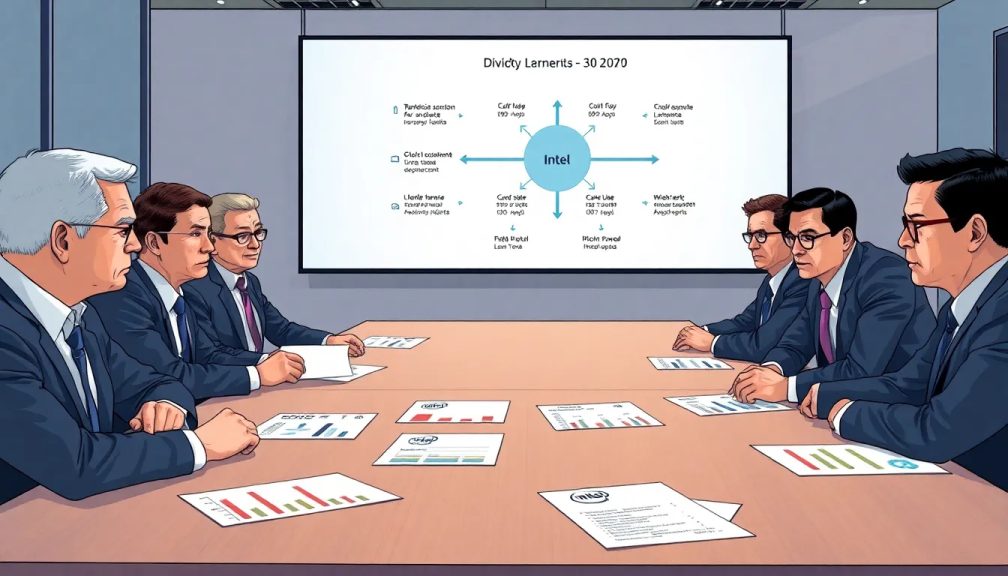Intel executives behind decline now suggest splitting company into 5 parts to save it

For over a decade, Intel has faced a tumultuous journey marked by poor decisions and strategies that have driven the company to the brink of collapse. Ironically, several of the same former executives who contributed to this downfall now claim to have the ultimate solution to save Intel. This historic American semiconductor company, celebrated by some and criticized by others, may need to divide into multiple parts to regain its former glory. But what is the rationale behind this drastic suggestion?
This proposal comes at a time when Intel appears to be slowly recovering, buoyed by financial backing from the U.S. government, which holds just under 10% of the company, and NVIDIA, who has recently acquired nearly 5% stake in Intel as part of a strategic investment.
Former Intel executives propose breaking the company into five distinct divisions
According to the ex-executives, the roadmap is straightforward: Intel should cease being a publicly traded company, split into five distinct divisions, and reinvent itself from the ground up. As stated in an interview with Fortune, they argue that the pressure from quarterly earnings reports prevents the company from making necessary changes. Transitioning to a private entity could facilitate the surgical corporate restructuring that Intel desperately needs.
Central to their proposal is the idea of splitting the core business into two main entities. One would focus exclusively on chip manufacturing, aiming to match or outperform the capabilities of Taiwan Semiconductor Manufacturing Company (TSMC). The other would concentrate solely on chip design, moving away from the once-powerful vertical integration model that has become increasingly untenable in today’s competitive landscape.
- Creation of a manufacturing-focused company
- Establishment of a design-only entity
- Sale of Mobileye, valued at $15 billion
- Divestment of its venture capital arm
- Focus on streamlining operations
To justify this strategy of dividing the company, these former Intel leaders point to the successful breakup of General Electric, which saw a significant revaluation after separating into various divisions. They contend that Intel suffers from the so-called “conglomerate discount,” where overly diversified companies are penalized by the market. Their quick calculations suggest that the standalone unit for PC microprocessors could be worth $100 billion, while the server and data center unit could fetch another $100 billion.
The potential role of Big Tech in Intel's future
Moreover, as part of their comprehensive plan, they envision that the U.S. government could lead a consortium of major tech companies such as Microsoft, Apple, Amazon, Google, Qualcomm, and Broadcom to purchase all public shares of Intel. NVIDIA’s recent investment of $5 billion has demonstrated that the market would likely respond positively to such a move. This influx of capital, estimated to reach up to $100 billion over the next decade, would primarily support the new foundry business, allowing it to compete rigorously against TSMC.
They draw parallels with the breakup of AT&T in the 1980s, which was completed in just over a year. They assert that a similar timeline could be feasible for Intel, with all divisions ready to be sold or go public again by 2028, providing substantial returns for private investors and U.S. taxpayers alike.
However, the core issue remains: should we trust the very individuals who previously championed an outdated vertical integration model—the same approach that contributed to the company's internal morale collapse and talent exodus during the surge of AI innovation? Now, after their departure, they are advocating for the dismantling of Intel, framing it as the sole pathway to create the semiconductor ecosystem that the United States needs to reduce its dependency on Taiwan.
This situation raises important questions about the credibility of these ex-executives. Can they genuinely offer a solution when they were part of the problem? Are their motivations entirely altruistic, or do they have hidden agendas? The debate is ongoing, with both sides presenting compelling arguments. Nevertheless, it is indeed ironic that those who once led the company to its current predicament are now proposing a solution that seems conveniently timed after NVIDIA's substantial investment.




Leave a Reply